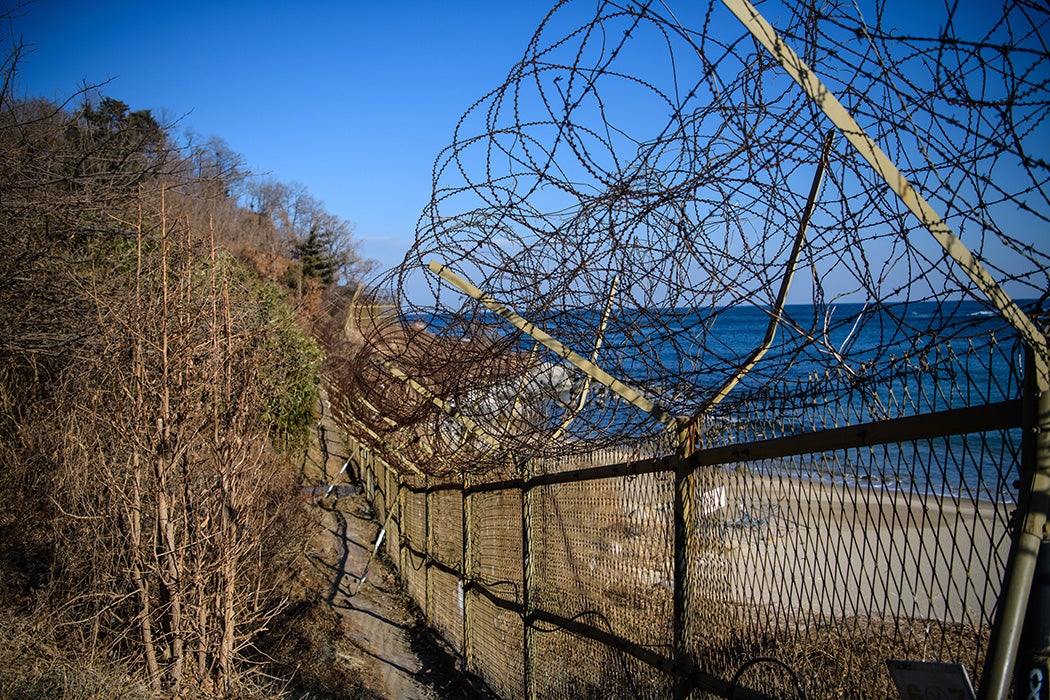Lately, some humans have been imagining what happens on an Earth without us. Documentaries such as Life After People and books such as The World Without Us and Islands of Abandonment are just some of the examples. It’s not just a hypothetical exercise. There exist case studies, including the Chernobyl Exclusion Zone and the 155-mile long, 2.5-mile wide demilitarized zone (DMZ) between North and South Korea.
What happened in the DMZ?
The DMZ was established in 1953 as a no-person’s zone between the warring halves of the peninsula. Populations were removed, and the area was seeded with landmines. On either side of the DMZ in civilian control zones (CCZ), fortifications were stocked with solders and materiel. Both North and South Korea are allowed to have small “Peace Villages” in the DMZ; the North’s is a propaganda showcase staffed by a “skeleton maintenance crew”; the South’s has around 200 residents who market DMZ-grown rice. Otherwise, the Zone is deadly to humans: some 800 soldiers have been killed during flare-ups in and around the DMZ since the war ended without a peace treaty.
More than 28,000 American soldiers remain stationed in South Korea. The un-ending division between the two halves of the peninsula and the Korean people hasn’t exactly been a triumph of diplomacy, yet as an accidental nature preserve, the DMZ is one of Asia’s marvels.
“Establishing a wildlife preserve was never a goal of the armistice that ended the Korean War, of course,” writes historian Lisa M. Brady, but that’s precisely what happened once people were essentially banned from the area.
“A wide variety of Korea’s native plants and animals, as well as numerous migratory species, were the direct beneficiaries,” she explains. “For some, like the red-crowned or Manchurian crane, the existence of the sanctuary has meant the difference between survival and extinction.”
Though it’s narrow, the cross-peninsula DMZ “represents a nearly complete set of Korean ecosystems within its boundaries, ranging from wetlands to grasslands to mountainous highlands.” The area had been intensively farmed before the war, and much fought over during the war—the line of battle was directly along the center of the Korean DMZ, the front marked by the so-called the Military Demarcation Line. But since the armistice, the area has been largely untouched by human hands. For seven decades now, nature has been in charge, establishing a “new ecological regime”: a corridor of rich biodiversity otherwise vanquished from the peninsula by brutal colonial exploitation, devastating war, and rapid industrialization and economic development.
Scientists can’t get into the DMZ, but satellite data, studies in the bordering CCZ, and anecdotal evidence suggest there are “1,200 plant species, 83 fish varieties, 51 different mammals […], and numerous birds, insects and microorganism” to be found there now. “Many of these species,” Brady continues, “are listed as threatened or endangered and some were even thought to be extinct.”
Some of the most celebrated of the DMZ’s animals are Asia’s iconic crane species, the White-naped and the Red-crowned, who use the oasis during their annual migrations north and south. And hopes for revival of the Siberian or Amur Tiger, which once ranged throughout the mountainous peninsula and may still hold on in the North, have centered on the DMZ. (Korea was once called the Land of Tigers; though culturally significant, the last tigers in the south were gone by the mid-1940s.)
Weekly Newsletter
Ironically, better diplomatic relations, tourist development, even unification, all potentially threaten this accidental preserve. Hence the idea of making the area a Peace Park, or, as entomologist Ke Chung Kim proposed in the mid-1990s, turning the DMZ and a three-mile buffer zone on either side of it into the Korean Peace Bioreserves System. The reserve would total some 1,600 square miles. He and others have suggested that environmental issues are an unprovocative subject for talks between the two Koreas.
As precedent, bird-watching and other ecotourism activities near the DMZ have already been established. Tourists can pass through the CCZ and look into the natural wonders of the DMZ itself. For the plants and animals, it seems to be Edenic, a state of nature before humans…or after them.
Support JSTOR Daily! Join our new membership program on Patreon today.







